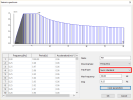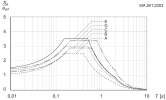Response spectrum generator according to SIA 261:2020 (Swiss standard)
Procedure to input a new SIA 261 seismic spectrum
- Expand branch Libraries of the main tree menu.
- Expand sub-branch Loads.
- Start function Seismic spectrum to open the Seismic Spectrum Manager.
- Click button .
- In combo box Input type select option Swiss standard.
- Review and, if required, adjust the spectrum parameters.
- Click button to review or modify the code-defined parameters of the spectrum.
- Confirm the code parameters with .
- Click to confirm the spectrum.
- Close the Seismic Spectrum Manager.
Spectrum definition and code parameters
A response spectrum can be defined according to SIA 261:2003 by selecting Swiss standard as Input type.
Max frequency & Step
The values of the spectrum are generated between a maximum period of 4 seconds (=0.25 Hz) and the input maximum frequency, using the input Step value.
Code parameters
This button opens the dialogue defining the code-dependent parameters.
Spectrum type
- Design - design response spectrum
- Elastic - elastic response spectrum
Seismic zone
Seismic hazard zone: Z1a, Z1b, Z2, Z3a, Z3b, Other
Other allows to define manually the ground acceleration agd
Coeff accel. ag
Ground acceleration divided by g (acceleration of gravity, defined in project settings)
agd
Ground acceleration, depending on the seismic hazard zone
Soil class
Foundation soil class, as defined in SIA 261 Table 25: A, B, C, D, E, Other
Other allows to define manually the soil parameters S, TB, TC, TD
S, TB, TC, TD
Soil parameters, as defined in SIA 261 Table 25
Building class
Structural class of the building: CO I, CO II, CO III, Other
Other allows to define manually the value Gamma f
Gamma f
Importance factor, depending on the selected building class, according to SIA 261 Table 26
Direction
Direction of the seismic action: Horizontal, Vertical, Other
Sets the value of the global factor. Other allows to define manually the value of the global factor.
For Vertical, the value of the behaviour factor q is checked and reduced if greater than 1.5
Global factor
Overall coefficient that multiplies the entire response spectrum. Depends on the direction of the seismic action: 1.0 for horizontal, 0.7 for vertical, user defined for other.
Behaviour factor q
Seismic behaviour factor
Damping xi
Relative damping ratio, for elastic response spectrum only.Default value = 0.05.
Eta
Damping correction factor, calculated from the relative damping ratio xi.
Theoretical background
Elastic response spectrum
SIA 261 Table 25: Soil Classes
For vertical component of seismic action, multiply all spectrum values by 0.7.
Design response spectrum
For vertical component of seismic action, multiply all spectrum values by 0.7. The behaviour coefficient q shall be taken not more than 1.5.
SIA 261 Table 26: structural classes
| Structural class CO |
γf |
| I | 1.0 |
| II | 1.2 |
| III | 1.5 |
SIA 261 16.2.1.2: Ground acceleration values
| Seismic Hazard Zone | agd [m/s2] |
| Z1a | 0.6 |
| Z1b | 0.8 |
| Z2 | 1.0 |
| Z3a | 1.3 |
| Z3b | 1.6 |




